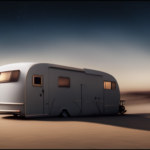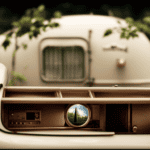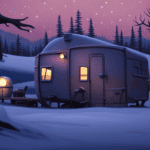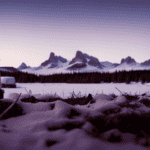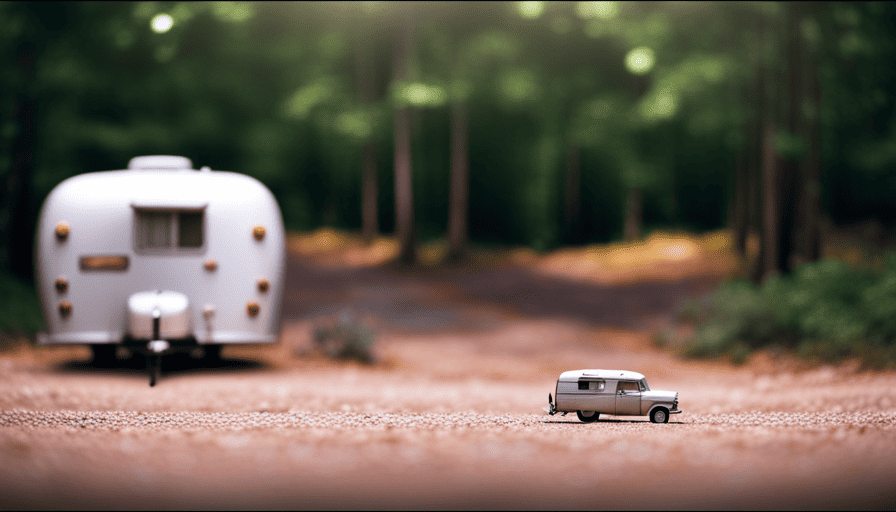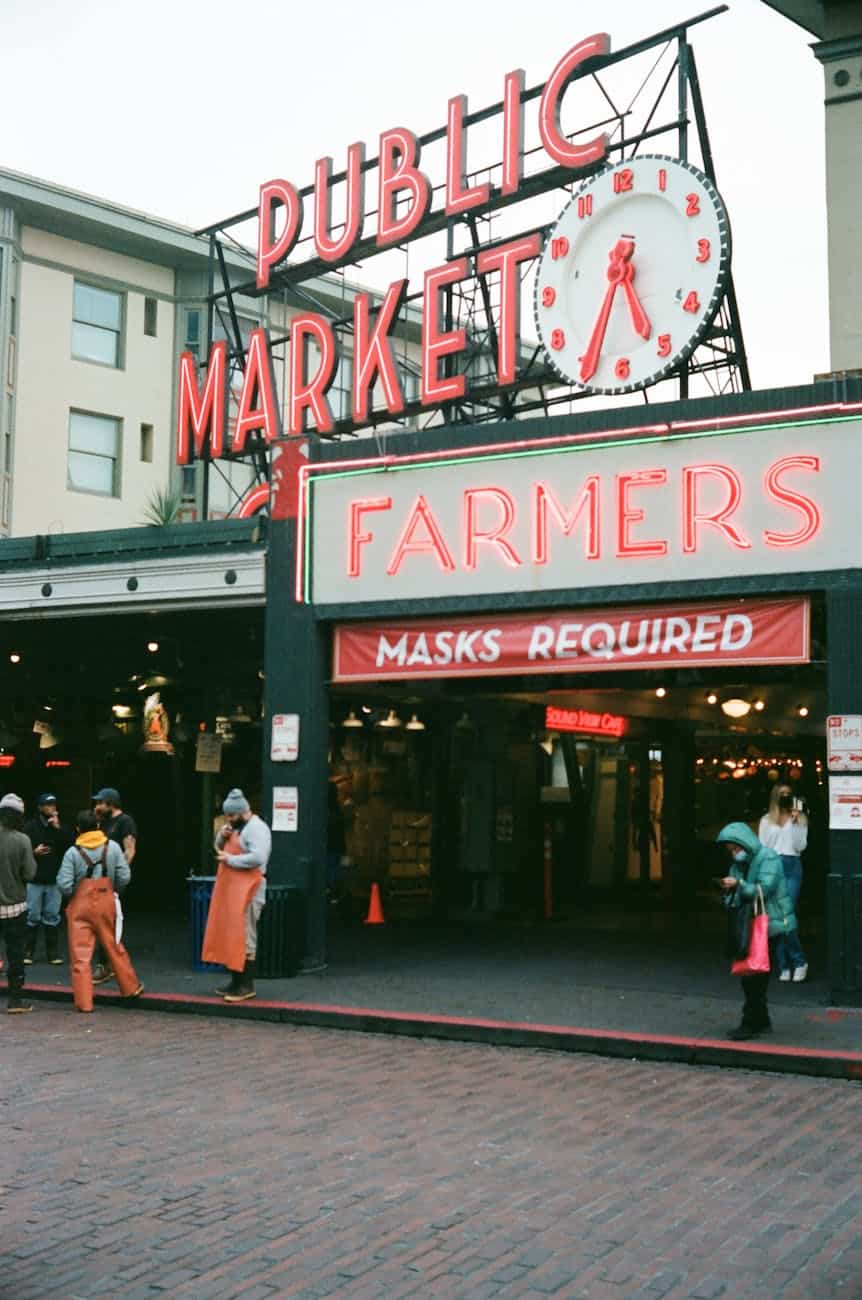Picture yourself driving down the highway in your cherished RV, with the breeze in your hair and a sense of liberation in your heart. You arrive at a charming campsite, eager to unwind and immerse yourself in the splendor of the great outdoors. However, upon opening the door to your comfortable mobile home, you are greeted by an unwelcome sight – a family of mice has taken up residence in your camper.
Suddenly, your dream getaway turns into a nightmare.
But fear not, fellow adventurer! I’ve been there, and I’m here to share my tried-and-true methods for keeping those pesky critters out of your camper.
From sealing entry points to using natural repellents, setting traps, and keeping your camper clean and clutter-free, I’ve got you covered.
I’ll even share tips for securing outdoor storage and using electronic repellents.
And if all else fails, I’ll guide you on when it’s time to seek professional help.
So grab a cup of coffee, pull up a chair, and let’s dive into the world of mice-proofing your camper. Trust me, you’ll be back on the road to adventure in no time!
Key Takeaways
- Seal entry points with silicone caulk, steel wool, or copper mesh
- Store food in airtight containers and clean up spills immediately
- Use natural repellents like peppermint oil, dryer sheets, vinegar, or ammonia
- Consider using humane catch and release traps or ultrasonic repellents
Seal all Entry Points
You’ve got to seal up all the entry points if you want to keep those pesky mice out of your camper. Mice can fit through incredibly small openings, so it’s crucial to thoroughly inspect your camper for any gaps or cracks.
To effectively seal these entry points, you can use a combination of sealing methods and prevention techniques. Start by examining the exterior of your camper and look for any visible holes or openings. Use a high-quality silicone caulk to seal these gaps, paying extra attention to areas around pipes, vents, and utility connections. For larger openings, consider using steel wool or copper mesh, as mice are unable to chew through these materials.
Next, move to the interior of your camper and inspect the walls, floors, and ceilings. Look for any gaps or cracks and seal them with caulk or weatherstripping. Don’t forget to check around windows and doors, as these are common entry points for mice.
By sealing all the entry points, you’re taking a proactive approach to keep mice out of your camper. However, it’s important to also remove potential food sources to make your camper less attractive to these critters.
Remove Potential Food Sources
By eliminating any accessible food, you can starve those pesky critters out of your camper, leaving them with an empty belly and no reason to stick around. Here are some ways to prevent mice from entering your camper and keep them away from your food:
-
Store all food in airtight containers: Mice can easily chew through packaging, so make sure all your food is stored in sealed containers to prevent them from smelling and accessing it.
-
Clean up spills and crumbs immediately: Mice are attracted to even the tiniest food particles, so be diligent about cleaning up any spills or crumbs as soon as they happen.
-
Empty and clean your pantry regularly: Regularly inspect your pantry for any signs of mice, such as droppings or chewed packaging. Empty it completely, clean it thoroughly, and check for any entry points that mice could be using.
-
Avoid leaving pet food out overnight: If you have pets, make sure to feed them during the day and remove any leftover food before nighttime. Mice are nocturnal creatures and are more likely to come out and search for food at night.
By following these simple steps, you can greatly reduce the chances of mice finding food in your camper. However, if you want an extra layer of protection, there are natural repellents you can use to keep mice away. [Transition sentence into the next section about natural repellents.]
Use Natural Repellents
To add an extra layer of protection against unwanted critters, try incorporating natural repellents into your camping routine. Natural deterrents can help keep mice out of your camper without the use of harmful chemicals.
One effective method is to use homemade remedies such as peppermint oil or dryer sheets. Mice are known to dislike the strong scent of peppermint, so you can place a few drops of peppermint oil on cotton balls and strategically place them around your camper to deter mice. Similarly, mice are also repelled by the scent of dryer sheets. You can place these sheets in areas where mice are likely to enter, such as near vents or openings.
Additionally, you can try using natural substances like vinegar or ammonia, as mice are known to dislike these smells as well. Just make sure to use these substances safely and avoid any contact with your skin or eyes.
By incorporating these natural repellents into your camping routine, you can help keep mice away from your camper and enjoy a critter-free camping experience.
Transitioning to the next section, it’s also important to set traps to catch any mice that may have already entered your camper.
Set Traps
When it comes to setting traps to catch mice in a camper, there are a few key points to consider.
First, it’s important to place snap traps in areas where mouse activity has been observed, such as near food sources or along walls.
Additionally, using humane catch and release traps can be a more compassionate option for those who prefer not to harm the mice.
Lastly, some people find success in using ultrasonic repellents to deter mice from entering their camper in the first place.
Place Snap Traps in Areas of Activity
If you want to keep mice out of your camper, try placing snap traps in areas where you’ve noticed their activity. Did you know that the average mouse can produce up to 50 droppings per day? Snap traps are effective in catching mice and preventing them from causing further damage. Before setting the traps, make sure to clean up any food crumbs or spills, as mice are attracted to these.
Additionally, consider using natural deterrents such as peppermint oil or mothballs to repel mice from entering your camper. These preventative measures, along with snap traps, can help eliminate mice and prevent future infestations. Once you’ve successfully caught the mice, remember to release them humanely into the wild, away from your camper. This ensures that they don’t return and cause any more trouble.
Use Humane Catch and Release Traps
Using humane catch and release traps allows for a compassionate and effective way to remove unwanted critters from your camper. Not only does this method prioritize the ethical treatment of animals, but it also ensures that you can safely relocate them without causing harm. Here are three key discussion ideas to consider when using catch and release traps:
-
Ethical considerations: By opting for humane traps, you demonstrate empathy towards the mice and contribute to their well-being. It’s important to respect all living creatures, even those considered pests.
-
Effectiveness of catch and release traps: These traps are highly effective in capturing mice without causing them any harm. They provide a safe and secure environment until you can release them back into their natural habitat.
-
Practicality and convenience: Catch and release traps are easy to set up and require minimal effort to maintain. They can be placed strategically in areas of mouse activity, ensuring maximum effectiveness.
Transitioning into the subsequent section, it’s also worth considering ultrasonic repellents as an additional measure to keep mice out of your camper.
Consider Ultrasonic Repellents
To protect your camper from unwanted furry visitors, consider adding ultrasonic repellents. These devices emit high-frequency sound waves that are inaudible to humans but unbearable for mice. It’s like a symphony of sound waves that creates a force field against intruders.
Ultrasonic repellents are a popular choice for keeping mice out of campers because they’re non-toxic and don’t harm the animals. However, it’s important to note that their effectiveness may vary. Some users report great success with these devices, while others find them less effective compared to other methods such as traps or deterrent sprays.
Additionally, there are potential downsides to using ultrasonic repellents. Some people claim that mice can become accustomed to the sound over time, rendering the device ineffective. Therefore, it’s important to regularly assess the effectiveness of the repellents.
To further enhance the effectiveness, it’s recommended to keep the camper clean and clutter-free, as this will minimize hiding spots for mice.
Keep the Camper Clean and Clutter-Free
A tidy and organized camper is the key to keeping pesky mice away. Implementing effective organizing strategies and prevention methods will help ensure that your camper remains mouse-free. Start by decluttering your camper and removing any unnecessary items that may attract mice. Store all food in airtight containers to prevent mice from smelling and accessing it.
Clean up any spills or crumbs immediately to avoid attracting mice with food sources. Regularly vacuum and sweep the floors, paying extra attention to crevices and corners where mice may hide. Seal any gaps or cracks in the walls, floors, and windows to prevent mice from entering. Use steel wool or caulk to fill in these openings effectively.
Lastly, keep your camper well-ventilated to discourage mice from making it their home.
Now that your camper is clean and clutter-free, it’s time to move on to the next step: using deterrent scents.
Use Deterrent Scents
One way to keep pesky mice away from your camper is by using deterrent scents, such as peppermint oil. Research has shown that mice are highly sensitive to the strong scent of peppermint, and it can be an effective natural repellent. You can easily create a peppermint oil spray by mixing a few drops of peppermint oil with water and spraying it around the camper. Another option is to soak cotton balls in peppermint oil and place them strategically around the camper, focusing on areas where mice are likely to enter.
In addition to peppermint oil, there are other scents that can also deter mice. For example, the smell of dryer sheets, ammonia, or even cat litter can help keep mice away. Experiment with different scents to find what works best for you.
It’s important to note that while these scents can be effective deterrents, they may not provide a foolproof solution. Mice are resourceful creatures and may still find a way into your camper. That’s why it’s crucial to implement other preventive measures, such as securing outdoor storage, to ensure a mouse-free environment.
Secure Outdoor Storage
Securing outdoor storage is essential for creating a mouse-free environment in your camper. By implementing effective outdoor storage solutions, you can greatly reduce the chances of rodent infestations. Here are three key steps to help you prevent mice from entering your camper through outdoor storage:
-
Seal all openings: Inspect your camper thoroughly for any gaps, holes, or cracks that mice could squeeze through. Use caulk or weatherstripping to seal these openings and prevent mice from finding their way in.
-
Elevate storage containers: Store your belongings in plastic bins or metal containers that are elevated off the ground. This will make it harder for mice to access and nest inside them.
-
Use rodent-proof materials: Opt for storage solutions made of materials that mice cannot chew through, such as metal or hard plastic. Avoid using cardboard boxes or soft fabrics that can be easily penetrated by rodents.
By following these outdoor storage practices, you can significantly decrease the likelihood of mice entering your camper. Regularly inspecting the camper is another important step in maintaining a mouse-free environment.
Regularly Inspect the Camper
Regularly examining your camper is like being a vigilant detective, searching for any signs of unwanted visitors or potential entry points. Inspecting your camper on a regular basis is essential to preventing a mouse infestation.
Start by checking the exterior of your camper for any openings or gaps where mice could squeeze through. Look for cracks in the walls, loose seals around windows and doors, and holes in the undercarriage. If you find any openings, seal them with caulk or steel wool to keep mice out.
Next, inspect the interior of your camper thoroughly. Look for telltale signs of mice, such as droppings, chewed wires or fabrics, and gnaw marks on furniture or walls. Pay special attention to dark and secluded areas, as mice prefer to hide in these spots. If you find any signs of mice, clean up the droppings and disinfect the area to prevent the spread of diseases.
To transition into the section about using electronic repellents, it’s important to note that while regular inspections are effective in preventing infestations, they may not completely eliminate the risk of mice entering your camper. That’s why it’s essential to take additional measures, such as using electronic repellents, to further deter these pesky rodents.
Use Electronic Repellents
To ensure a mouse-free camper, regularly inspecting it is crucial. However, sometimes inspections alone might not be enough. That’s where electronic repellents come in handy. These devices emit high-frequency sounds that are unbearable for mice, keeping them at bay.
The effectiveness of electronic repellents varies depending on the brand and model you choose, as well as the size of your camper. It’s important to read reviews and select a repellent with positive feedback.
Electronic repellents have several advantages. Firstly, they’re easy to use and require minimal effort to set up. Secondly, they’re safe for both humans and pets, as they don’t involve the use of harmful chemicals. Additionally, they’re cost-effective in the long run, as they eliminate the need for constant reapplication of repellent substances.
However, it’s important to note that electronic repellents might not be effective for every situation. Mice can become accustomed to the high-frequency sounds over time, rendering the repellents useless. In such cases, it’s essential to consider alternative methods such as using natural repellents or sealing any potential entry points.
If despite your best efforts, you still find yourself plagued by mice in your camper, don’t hesitate to seek professional help. They’ve got the expertise and tools to effectively rid your camper of these unwanted guests.
Seek Professional Help if Needed
If all else fails and you’re still plagued by those pesky creatures, don’t hesitate to seek professional help. Sometimes, no matter how many preventive measures you take, mice still find a way into your camper.
In such cases, it’s best to reach out to pest control services and seek professional advice. Professional pest control services have the expertise and experience to deal with mouse infestations effectively. They can assess the situation and provide tailored solutions based on the severity of the problem. These experts have access to a wide range of tools and techniques that can help eliminate mice from your camper and prevent them from returning.
When seeking professional help, it’s important to choose a reputable pest control company with a proven track record. Look for reviews and recommendations from other camper owners who have faced similar issues. A reliable company will not only get rid of the mice but also advise you on preventive measures to avoid future infestations.
Remember, dealing with mice in a camper can be challenging, but seeking professional help can make a significant difference. Don’t hesitate to reach out to pest control services for expert advice and effective solutions to keep those unwanted guests out of your camper.
Frequently Asked Questions
Are there any specific natural repellents that are more effective at keeping mice out of a camper?
Natural repellents and homemade remedies can be effective in keeping mice out of a camper. Some specific options include peppermint oil, used dryer sheets, and vinegar. Peppermint oil can be applied to cotton balls and placed strategically around the camper to deter mice. Used dryer sheets can also be placed in areas where mice may enter. Vinegar can be used to clean surfaces as the strong odor repels rodents.
These natural methods can help keep your camper mouse-free.
How often should I inspect my camper for signs of mice?
I inspect my camper for signs of mice on a monthly basis to ensure early detection and prevent any potential damage. It’s important to be thorough during the inspection, checking for droppings, chewed wires or insulation, and any unusual smells.
Additionally, I pay attention to any small openings or gaps where mice could potentially enter. By regularly inspecting my camper, I can address any signs of mice promptly and take necessary measures to keep them out.
Can I use electronic repellents in conjunction with other methods to increase their effectiveness?
Yes, electronic repellents can be used in conjunction with other methods to increase their effectiveness in keeping mice out of a camper. While traditional methods like sealing entry points and using traps are effective, ultrasonic repellents emit high-frequency sound waves that are unbearable for mice.
However, it’s important to note that the effectiveness of ultrasonic repellents may vary, as some studies suggest that mice can become immune to the sound over time. Therefore, it’s recommended to use a combination of both electronic repellents and traditional methods for better results in keeping mice away from your camper.
What are some common deterrent scents that mice dislike?
Some common deterrent scents that mice dislike include peppermint oil, cloves, and ammonia. These natural deterrents can be used as DIY mouse repellents to keep mice away from your camper.
Peppermint oil can be applied to cotton balls and placed in areas where mice are likely to enter.
Cloves can be used in sachets or sprinkled in areas where mice are active.
Ammonia can be diluted and sprayed around the perimeter of the camper to deter mice.
How do I secure outdoor storage to prevent mice from accessing it?
To secure outdoor storage and prevent mice from accessing it, there are a few practical tips you can follow.
First, seal any cracks or openings in the shed to eliminate entry points.
Next, consider using mouse deterrents such as peppermint oil or mothballs, as mice don’t like these scents.
Additionally, keep the storage area clean and organized, removing any potential food sources.
Finally, set up traps or use a mouse repellent device for added protection.
What Are Effective Methods for Keeping Mice Out of Campers?
Effective methods for keeping mice away from campers include sealing any openings with steel wool or caulk, storing food in airtight containers, and eliminating potential nesting sites. Additionally, removing any hiding spots and keeping the camper clean and clutter-free can deter mice. Using peppermint oil, mothballs, or ultrasonic devices may also help repel these unwanted guests.
Conclusion
In conclusion, keeping mice out of your camper is essential for a stress-free and enjoyable camping experience. By following these practical tips, you can create a mouse-free environment: One of the most effective methods for chipmunk removal is to seal off any potential entry points to your camper, such as gaps in the floorboards or holes in the walls. Additionally, setting up mousetraps or using natural repellents such as peppermint oil can help discourage chipmunks from entering your camper. By taking these preventive measures, you can ensure that your camping trip is free from unwanted furry visitors. In addition to these tips, it may also be helpful to research and implement chipmunk removal methods if you are camping in an area where they are prevalent. By being proactive and taking preventive measures, you can ensure that your camper remains free of pests and critters, allowing you to fully relax and enjoy your time in nature. With a little effort and planning, you can create a comfortable and safe space for yourself and your fellow campers.
- Seal entry points.
- Remove potential food sources.
- Use natural repellents.
Don’t forget to regularly inspect your camper and keep it clean and clutter-free to minimize the chances of mice infestation. Remember, prevention is key, but if all else fails, don’t hesitate to seek professional help.
With these measures in place, you can bid farewell to those pesky rodents and embrace a worry-free camping adventure. As the saying goes, "An ounce of prevention is worth a pound of cure," and in this case, it couldn’t be more true.




